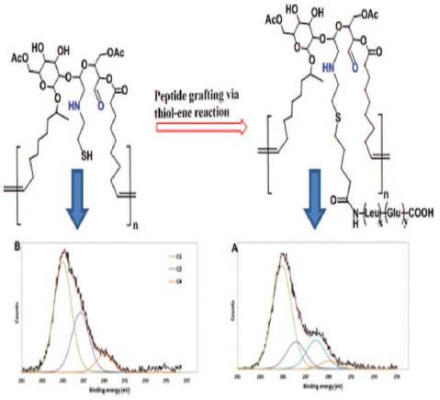多肽改性含糖共聚物电纺纤维
Abstract
Oligo(Glu70-co-Leu30), a peptide synthesized by protease catalysis, is functionalized at the N-terminus with a 4-pentenoyl unit and grafted to polyLSL[6′Ac,6″Ac], a glycopolymer prepared by ring-opening metathesis polymerization of lactonic sophorolipid diacetate. First, polyLSL[6'Ac,6”Ac] fiber mats are fabricated by electrospinning. Oxidation of the fiber mats and subsequent reaction with cysteamine lead to thiol-functionalized fiber mats with no significant morphology changes. Grafting of the alkene-modified oligopeptide to thiol-functionalized polyLSL[6′Ac,6″Ac] fiber mats is achieved via “thiol-ene” click reaction. X-ray photoelectron spectroscopy analysis to characterize peptide grafting reveals that about 50 mol% of polyLSL[6′Ac,6′′Ac] repeat units at fiber surfaces are decorated with a peptide moiety, out of which about 1/3 of the oligo(Glu70-co-Leu30) units are physically adsorbed to polyLSL[6′Ac,6′′Ac]. The results of this work pave the way to precise engineering of polyLSL fiber mats that can be decorated with a potentially wide range of molecules that tailor surface chemistry and biological properties.

本文介绍了聚LSL[6’Ac,6” Ac]电纺纤维的织造和固态表征过程,并记述了聚LSL[6’Ac,6” Ac]非织造毡与多肽的多种耦联过程。X光光子光谱分析结果说明,约表面50mol%的聚LSL[6’Ac,6” Ac]重复单元被多肽修饰,其中有1/3的多肽被聚LSL[6’Ac,6” Ac]物理吸附。




 齐岳微信公众号
齐岳微信公众号 官方微信
官方微信 库存查询
库存查询